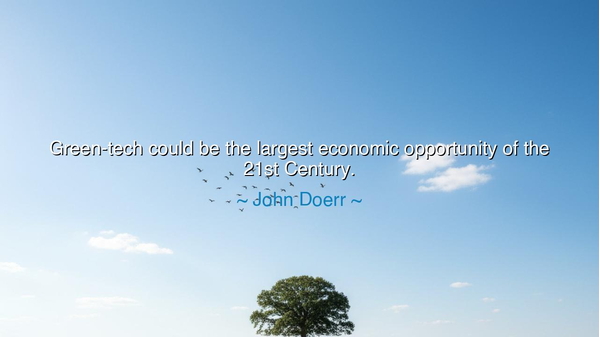
Green-tech could be the largest economic opportunity of the 21st






Hear the herald’s cry cast into our century: “Green-tech could be the largest economic opportunity of the 21st Century.” In this short trumpet-blast, John Doerr names a hinge of history. He does not speak of charity, nor of penance, but of engines and markets, of craft and gain aligned with the saving of our only home. The old mills turned on coal and conquest; the new mills turn on sun, wind, water, storage, efficiency, and the intelligence that braids them. If the past built empires by digging downward, the future will build commonwealths by reaching outward—to light, to motion, to design.
Consider what is meant by opportunity. It is not a single mine to be emptied, but a vast choreography of trades: miners of data instead of ore, smiths of batteries instead of bayonets, masons who stitch buildings so tight that winter cannot enter, sailors of electrons who steer power from rooftop to grid with barely a whisper lost. Green-tech is not one device; it is an ecosystem—generation, transmission, storage, software, materials, recycling—each a revenue river, all joining into a sea. Where the old economy spent its strength fighting the very physics it provoked, the new seeks partnership with thermodynamics, with aerodynamics, with chemistry’s quiet laws.
Mark a story fit for the annals. In the wake of the oil shocks, a small, wind-swept kingdom turned its face from scarcity to invention. Farmers raised towers where barley once swayed; engineers carved quieter blades and sturdier hubs; shipwrights became turbine-makers; an energy company laid down petroleum and took up the work of offshore wind. Jobs multiplied not in rumor but in payroll, exports, and pride. What began as necessity ripened into mastery, and mastery into markets across the world. Thus a nation learned that Green-tech is not a sermon—it is a supply chain, a school of skills, a balance sheet made brave.
Or take the tale of a coastal city that pledged to reclaim its air. At first, it bought a few electric buses, installed a scattering of chargers, and patched leaky buildings. Then came the flywheel of savings: lower fuel costs funded more vehicles; healthier lungs eased hospital burdens; local firms learned to assemble, maintain, and then to design. Apprenticeships flourished; contractors matured into manufacturers; software shops tuned fleets and thermostats with algorithms that slept only when the city slept. Investment begat competence, and competence beckoned more investment. The virtuous circle spun, humming in the key of the 21st Century.
See also the ledger of risk and reward. In every age, fortunes were made by those who stepped where the map was faint. Steel eclipsed iron; silicon eclipsed vacuum tubes; networks eclipsed lonely terminals. So too will Green-tech eclipse the engines that feed upon their own tail. The prize is not only measured in coin; it is counted in resilience—cities that do not drown when grids stumble, farms that do not fail when heat stalks the fields, households that do not flinch at price shocks because their roofs harvest day and their walls husband night. This is the largest economic opportunity because it sells what every buyer needs: lower costs, steadier service, and a future that can still breathe.
Yet let none mistake the path for a parade ground. The work asks courage of many kinds: miners to unearth cleaner materials and then to unearth them again from yesterday’s devices; financiers to prize long horizons; lawmakers to bind ambition into standards; artisans to design for repair as well as for beauty. But the compass is sure. Each avoided ton of waste and smoke is not only a blessing to the lungs—it is an annuity to the ledger. Each watt spared by efficiency is the cheapest plant never built. Thus the moral law and the market law, long at odds, discover that they can walk the same road.
Take from this an oath and a plan. Builders: specify heat pumps, tight envelopes, recycled steel; let every project be a tiny power plant. Founders: hunt for frictions—battery degradation, grid congestion, supply-chain traceability—and turn them into products. Workers: learn the crafts the future pays for—power electronics, retrofits, controls, lifecycle analysis. Investors: measure true value—total cost of ownership, avoided volatility, durability. Citizens and leaders: weave incentives with accountability—clear standards, open data, predictable rules. Do these things steadily, and the prophecy will become a census: factories lit, ports humming, rooftops earning, streets breathing—proof that Green-tech, rightly tended, is indeed the largest economic opportunity of the 21st Century.






AAdministratorAdministrator
Welcome, honored guests. Please leave a comment, we will respond soon